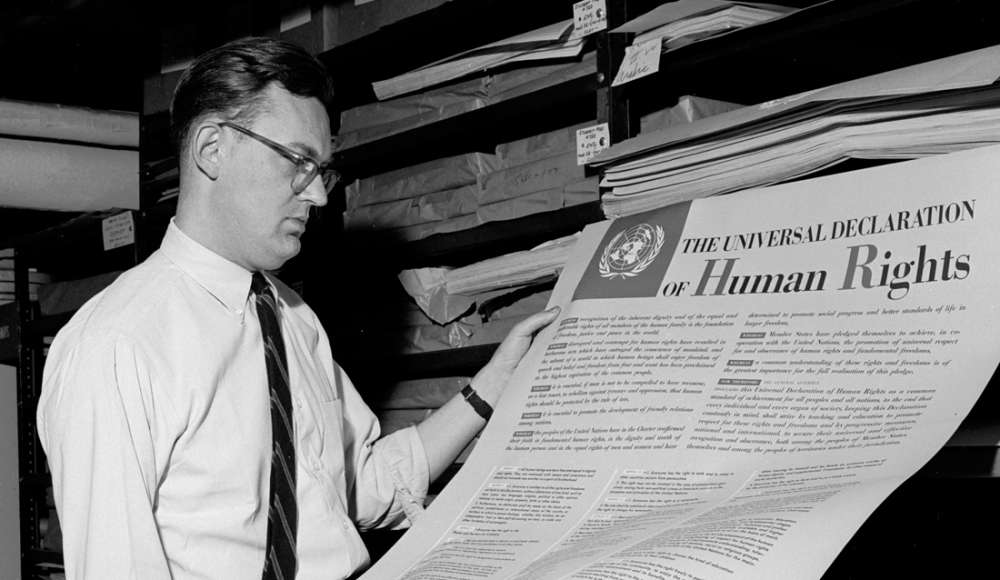China’s White Paper on Human Rights

Executive Summary
As a consequence of the Chinese government’s violent repression of the Tiananmen Square protests on June 4, 1989, human rights have become a central topic in the foreign relations of the People’s Republic of China. The Chinese party-state was internationally criticized for the massacre, and its reputation worldwide severely damaged. Some states – including the United States and all members of the European Union – imposed political and economic sanctions. On August 31, 1989, the UN Sub-Commission on the Promotion and Protection of Human Rights adopted a critical resolution. In November 1991, the chief administrative authority of the People’s Republic, the State Council, responded to the unflagging international criticism with the publication of its first white paper on human rights. Propagating a relativistic position, the paper fueled a heated international debate about the universality of human rights ahead of the 1993 World Conference on Human Rights. The 1991 white paper defines the main features of Chinese human rights diplomacy to this day. It offers a good example of an authoritarian state attempting to rebut international human rights criticism through the use of counter-discourse.
Origins of the White Paper
The 1991 white paper is a key foreign policy document from post-Maoist China and the first official document of the PRC to explicitly recognize the concept of human rights. Under Mao Zedong, human rights were still dismissed as a catchphrase of the bourgeoisie: individual rights protection did not have a place in class struggle. This changed on December 4, 1982, a few years after Mao’s death. Spurred by Deng Xiaoping’s reform and open door policy, China adopted a new constitution that attached less importance to class struggle and featured a chapter on the rights of citizens. These included, among others, equality before the law; freedom of speech, assembly and belief; and the right to work, recreation, education and care in the case of illness and retirement. But the chapter does not only grant rights, but also specifies duties, and it explicitly subordinates rights to the interests of the state, society and collective (Art. 51). In contrast to the concept of human rights, which has a universal claim to validity and awards every individual with natural rights, the civil rights contained in the 1982 Chinese constitution depend on the behavior of citizens. The same constitution applies in China to this today. However, it has seen a number of amendments, and in 2004 it was amended with a clause that, rather vaguely, promises respect for human rights.
White papers provide guidance for political action and are meant to justify a particular policy course vis à vis foreign countries. It is difficult to establish how exactly the 1991 white paper was formulated between Chinese officials and party cadres because such decision-making procedures are not transparent in China. We do know, however, that prior to its publication in November 1991, a series of human rights conferences took place that may have influenced the official Chinese position. For instance, the Chinese Academy of Social Sciences held a symposium in June 1991 on human rights.[1] The academy is not an independent scientific research center, but directly subordinate to the State Council as well as to the party-state’s political calculus. In other words, the white paper was the result of consultations between establishment experts and propaganda officials. According to the Swedish sinologist Marina Svensson, state officials repeatedly discussed how to counter or appease the international human rights criticism that followed the Tiananmen massacre of 1989.[2] Public consultations by the party-state with independent Chinese legal scholars or relevant civil society actors did not take place. Therefore, the 1991 white paper should be understood as a foreign policy instrument of the Chinese party-state and not as a reflection of the Chinese domestic debate on human rights.
The People’s Republic has a powerful propaganda system (xuanchuan xitong) that is spearheaded by the propaganda department of the Communist Party’s Central Committee. In accordance with the party’s Leninist tradition, the term “propaganda” is perceived positively by Chinese communists and describes the mediation between the communist ideology and the censorship of competing ideas. Due to its negative connotations abroad, the Chinese party-state prefers to use other terms in foreign languages, such as “publicity department” instead of “propaganda department” in English. In Mandarin, however, the term “propaganda” is used in its original meaning to this day.
Responsible for the so-called “ideological work” of the party-state, the propaganda department of the Central Committee played an important role in the drafting of the 1991 white paper. In the Chinese party-state, party structures and state bodies are closely connected. The bureaucratic implementation of propaganda and censorship is performed by state bodies. The Information Office of the State Council, which published the white paper, is part of this propaganda system. The Information Office was instituted on January 25, 1991, but it is identical to the External Propaganda Department of the Communist Party’s Central Committee, established on April 8, 1980. Such practice of double naming is not uncommon in China. It is called yige jigou, liangge paizi – one body, two signs – and implies a combination of state administration and Communist Party structure.[3]
Although the white paper was officially published under the harmless label of the State Information Office, it is a product of the propaganda apparatus of the Chinese Communist Party. In 1991, the year of the white paper’s publication, the Information Office was managed by Zhu Muzhi, a longtime propaganda cadre. His responsibilities included not only the preparation of the white paper, but also the development of propaganda specially designed for foreign journalists, foreigners living in China, businessmen and tourists. As early as June 17, 1989, just a few days after the Tiananmen massacre, Zhu reportedly prepared other cadres of the propaganda department for the “struggle for the public opinion.”[4] Two years later, he took over the Information Office, which was established only for this purpose, and here he prepared the first white paper about human rights in China. Subsequently, Zhu became the honorary president of the Chinese Society for Human Rights Studies, a state-controlled institution that acted as an NGO. In this position, Zhu defended China’s human rights situation from the criticism of foreign delegations that began visiting China for human rights dialogues.
China’s external propaganda was promoted by Jiang Zemin in particular, the former general secretary of the Central Committee and the future president of China.[5] Jiang used external propaganda in an effort to overcome China’s post-Tiananmen international isolation, which was further entrenched with the overthrow of communism in Central and Eastern Europe at the end of 1989. Because China needed foreign investment in order to drive economic modernization, its reputation abroad was important for the political leadership. The 1989 massacre having severely damaged the party’s domestic legitimacy, China’s economic rise became an important stabilizing factor for the regime. Therefore, it was crucial for the Chinese government to rebuke criticism, recover its reputation at home and abroad, and secure foreign investments. The first foreign policy paper on human rights in the history of China offered party cadres and diplomats a detailed argumentative guide for dealing with international criticism against China’s human rights situation.
Content
The white paper is organized in 10 chapters that follow a preface. The preface blames “the three mountains” of imperialism, feudalism and capitalism for human rights violations in Chinese history. Subsequently, it summarizes the official historiography of the party and presents the founding year of the People’s Republic as the starting point for improvements in China’s human rights situation.
Although the paper explicitly endorses the Universal Declaration of Human Rights, it also emphasizes that independent states must interpret and implement human rights in the context of their own historic, social, economic and cultural specificities. On this basis, the term “Chinese human rights” is introduced, making the white paper part of the culture relativistic school of thought. Moreover, the paper singles out state sovereignty as an indispensable condition for the protection of human rights. In contrast to the right to self-determination as contained in the Universal Declaration, the Chinese white paper emphasizes national independence rather than peoples’ self-determination as a requirement for human rights. While this line of argument is connected to the emphasis placed on self-determination by decolonized states since the 1950s, China clearly emphasizes state sovereignty, not people’s self-determination. This is because the right of people to self-determination is a captious, politically sensitive topic for the multi-ethnic state of China, notably with respect to the large autonomous areas. By emphasizing state sovereignty and national independence, the Chinese party-state characterizes human rights not as an international, emancipatory concept but as an internal affair. Consequently, it refuses to recognize criticism from abroad as legitimate.
In its 10 chapters, the white paper deals with different human rights topics and rejects common points of criticism raised against China’s human rights situation. According to the preface, it is the paper’s explicit aim to ensure that the international community understands China’s human rights situation “correctly.” The chapters discuss political rights such as the right to a fair trial, freedom of religion and rights of minorities, as well as economic, cultural and social rights, including the right to work, family planning and the rights of people with disabilities. The white paper also seeks to back a narrative of steady progress since the founding of the People’s Republic, providing a great deal of quantitative data and omitting data that contradict the official narrative. For instance, the white paper presents the number of victims caused by famines between 1943 and 1946 (i.e., shortly before the founding of the People’s Republic), but does not mention the most severe famine in China’s history, which took place between 1958 and 1962 as a result of Mao Zedong’s Great Leap Forward (first chapter). The latter is estimated to have caused deaths in the double-digit millions.
The white paper is not simply characterized by selective information; it also contains false claims. For example, the third chapter argues that in China, there is no censorship and freedom of opinion is respected. At the same time, however, the white paper refers to an important limitation to freedom of opinion by stressing the unity of rights and duties. In line with the Chinese constitution, the white paper explains that Chinese citizens are allowed to exercise their individual rights and freedoms only to the extent that they do not violate state interests, the interests of society at large or of the collective, and the rights of other citizens. While this limitation is vaguely worded, it does indicate the submission of individual rights to the primacy of the party-state (third chapter).
The centerpiece of the white paper is the so-called “right to subsistence” (shengcun quan), which is prominently placed in the first chapter. This right is supposed to outrank all others, for they would be of no value without subsistence. Although the white paper does not define this right, it does refer to Article 3 of the Universal Declaration of Human Rights: the right to life, liberty and security of person. A closer reading of the white paper suggests that the right to subsistence is supposed to describe a basic supply of housing, food and healthcare. It is unclear why this right holds such a prominent position in the paper, but we do know that Zhu Muzhi did not invent it. Ann Kent, an expert on China, assumes that the impact of American philosopher Henry Shue is at play: Shue highlighted the importance of subsistence in his work on basic rights in the beginning of the 1980s.[6] Marina Svensson, on the other hand, writes in her book on the human rights discourse in China that the corresponding Chinese term of shengcun quan already gained influence in the 1920s. Meanwhile, philosopher Stephen Angle argues that this idea has even older predecessors in the Chinese right discourse.[7]
The white paper does not locate the right to subsistence in a longstanding Chinese tradition, but calls its priority a “simple truth.” The paper does not discuss what it means to make the right to subsistence a legal entitlement; rather, it emphasizes the factual warranty of basic supplies. It is argued that what China accomplished in this field was only possible because the country fought off imperialistic subjugation. The white paper does not only warn about foreign actors that want to harm China under the false premise of human rights, but also emphasizes that social riots in China would endanger the right to subsistence. Accordingly, it claims that political stability must remain the top priority of China’s human rights policy (first chapter). Thereby, the white paper implicitly justifies the violent suppression of the Tiananmen movement.
References to historical, social, economic and cultural differences, the concept of “Chinese human rights” and the declared priority of the right to subsistence continue to provide Chinese diplomats with justifications for the human rights situation in China. They draw on these arguments during bilateral meetings with politicians and diplomats from liberal democracies, and they promote this counter-discourse in the human rights bodies of the United Nations as well.
History of Impact
The 1991 white paper is a propaganda document guiding China’s foreign human rights policy. Therefore, it is not a key text for China’s domestic human rights discourses. Nevertheless, its publication caused several domestic reactions. For example, a group of Chinese dissidents in Beijing who wanted to establish a liberal opposition party instantly published a reaction. They stated that though the government’s paper was full of lies and quibbles, it was nevertheless a success because the party-state now explicitly recognizes the Universal Declaration of Human Rights. According to the dissidents, the paper was a tactical concession in response to domestic and foreign pressure. Furthermore, they called on the Chinese government to respect all articles of the Universal Declaration and to release all political prisoners immediately. Reportedly, they were imprisoned shortly thereafter.[8]
The more important impact was discernable on the international stage. Chinese Prime Minister Li Peng mentioned the white paper’s key arguments during a speech when the UN Security Council met for the first time at the level of heads of state in January 1992. Chinese exile groups protested in front of the UN and set up a goddess of democracy made out of papier-mâché, as they had done during the Tiananmen protests. Inside the building, the Chinese prime minister argued that shared international human rights criteria would be neither appropriate nor practical because of different historical and national conditions, and he stressed the importance of state sovereignty, independence and the right to subsistence and development.[9]
In the early 1990s, China’s relativistic position also influenced the discussion on so-called “Asian values,” which were put forward primarily by China, Indonesia and Malaysia. The centerpiece of the Asian values argument was that the collective interest traditionally stood above individual rights in Asia. At the 1993 Global Conference on Human Rights, Chinese Vice-Foreign Minister Liu Huaqiu consequently argued, as already discussed in the 1991 white paper, that different states of development and diverse historical and cultural traditions inevitably lead to dissimilar understandings of human rights.[10] At the beginning of the World Conference, Liu showed no interest in compromise and rejected a draft final document. The joint declaration had to be negotiated and agreed upon by June 25, 1993, and up until June 20, observers of the conference publicly claimed that China was responsible for the blockade.[11] On June 22, John Pace, president of the conference and former official of the UN Office of the High Commissioner for Human Rights, finally indicated that an agreement had been reached.
Diplomats of the People’s Republic presumably cooperated in reaction to pressure from two sides: the Chinese position was critiqued by not only Chinese civil society, but also Western state representatives. For instance, John Shattuck, the American assistant secretary of state for human rights and democracy, wanted to ensure that the joint declaration recognized universal human rights without any restrictions. Besides, several Chinese exile organizations expressed their disagreement with the Chinese government by publishing a joint declaration on June 18, 1993. The dissidents stressed that human rights were universal and indivisible. Accordingly, no government should be allowed to violate international standards under the pretext of specific cultural, historical or national conditions. Moreover, the Chinese government would have to accept that civil, political, economic and social rights are mutually dependent. In this vein, the Vienna Declaration of 1993 declared that human rights are universal, indivisible and interconnected. Therefore, the People’s Republic was unable to assert its relativistic position in 1993.
Until today, China’s statements in human rights bodies of the UN have a similar content. Although the counter-discourse of the propaganda apparatus does not directly question human rights, the Chinese party-state still claims that the right to subsistence outranks civil and political rights. Chinese diplomats continue to emphasize the importance of historical, cultural, social and economic differences, interpret state sovereignty as absolute and repel international criticism about human rights violations as an illegitimate interference in domestic affairs. With respect to the central arguments, the People’s Republic has not changed its position for more than two decades. Later Chinese white papers about human rights continue the course that was first developed under propaganda official Zhu Muzhi, and the arguments developed in 1991 continue to be used by Chinese diplomats as a powerful counter-discourse. In this way, the propaganda apparatus of the Communist Party is helping to repel international criticism about China’s human rights situation and to stabilize authoritarian rule.
…
References
[1] Ann Kent, China, the United Nations and Human Rights: The Limits of Compliance (Philadelphia: University of Pennsylvania Press, 1999), 151.
[2] Marina Svensson, Debating Human Rights in China: A Conceptual and Political History (Lanham: Rowman and Littlefield, 2008), 268.
[3] David Shaumbaugh, “China’s Propaganda System Institutions. Processes and Efficacy,” The China Journal 57 (2007): 25 – 58, p. 30 and p. 47.
[4] Anne-Marie Brady, Marketing Dictatorship: Propaganda and Thought Work in Contemporary China (Lanham: Rowman and Littlefield, 2008), 154.
[5] Brady, Marketing Dictatorship, 155.
[6] Kent, China, the United Nations and Human Rights, 156.
[7] Stephen C. Angle, Human Rights and Chinese Thought (Cambridge: Cambridge University Press, 2002), 245.
[8] Svensson, Debating Human Rights in China, 258.
[9] United Nations Security Council, Provisional Verbatim Record of the Three Thousand and Forty-Sixth Meeting, S/PV.3046, January 31, 1992.
[10] Angle, Human Rights and Chinese Thought, 1.
[11] Kent, China, the United Nations and Human Rights, 181.
…
This is an English translation of a commentary originally published in German in December 2015.







